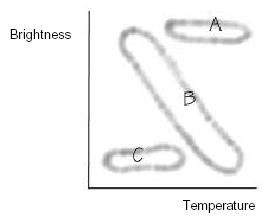 |
1 |  | 
We don’t see stars in the daytime because |
|  | A) | the sun blocks their view. |
|  | B) | they all set as the sun comes up. |
|  | C) | light from the sun overwhelms the light from the stars. |
|  | D) | the stars only emit light at night. |
 |
 |
2 |  | 
As a star undergoes collapse, its rate of rotation (Hint: think of an ice skater) |
|  | A) | increases. |
|  | B) | decreases. |
|  | C) | stays the same. |
 |
 |
3 |  | 
The stars that last the longest are those with |
|  | A) | the largest masses. |
|  | B) | the smallest masses. |
|  | C) | the largest radii. |
|  | D) | the hottest temperatures. |
 |
 |
4 |  | 
Ultimately the sun will end up as |
|  | A) | a white dwarf. |
|  | B) | a black hole. |
|  | C) | a neutron star. |
|  | D) | None of the above. |
 |
 |
5 |  | 
The iron in an old anvil was produced by |
|  | A) | chemical reactions. |
|  | B) | volcanoes. |
|  | C) | fission process in stars. |
|  | D) | fusion processes in stars. |
 |
 |
6 |  | 
How many stars have we sent space probes to? |
|  | A) | Several, but all nearby |
|  | B) | Just two |
|  | C) | One |
|  | D) | None |
 |
 |
7 |  | 
If two stars in the same constellation appear equally bright then we know that |
|  | A) | they must both be the same distance away. |
|  | B) | they both must have the same apparent brightness. |
|  | C) | they both must have the same intrinsic brightness. |
|  | D) | All of the above are true. |
 |
 |
8 |  | 
When we say a star like our sun has a “color” we mean that |
|  | A) | it shines with only one wavelength of light. |
|  | B) | it shines with a few wavelengths of light to produce a spectral pattern but most of the wavelengths are around the sun’s color. |
|  | C) | it shines with all wavelengths of light but the brightest wavelength corresponds to the sun’s color. |
|  | D) | it has an absorption line at the wavelength corresponding to the sun’s color. |
 |
 |
9 |  | 
In the HR diagram, where are the “normal” stars?
 <a onClick="window.open('/olcweb/cgi/pluginpop.cgi?it=jpg::::/sites/dl/free/0072509791/169261/dcqCh17fg01.jpg','popWin', 'width=318,height=289,resizable,scrollbars');" href="#"><img valign="absmiddle" height="16" width="16" border="0" src="/olcweb/styles/shared/linkicons/image.gif"> (18.0K)</a> <a onClick="window.open('/olcweb/cgi/pluginpop.cgi?it=jpg::::/sites/dl/free/0072509791/169261/dcqCh17fg01.jpg','popWin', 'width=318,height=289,resizable,scrollbars');" href="#"><img valign="absmiddle" height="16" width="16" border="0" src="/olcweb/styles/shared/linkicons/image.gif"> (18.0K)</a>
|
|  | A) | A |
|  | B) | B |
|  | C) | C |
|  | D) | In all three areas: A, B, and C |
 |
 |
10 |  | 
What remnants might we expect to see after a supernova? |
|  | A) | A black hole |
|  | B) | A pulsar |
|  | C) | A neutron star |
|  | D) | All of these |
|  | E) | None of these |
 |
 |
11 |  | 
If our Sun were to suddenly collapse and become a black hole with the same mass as it now has, what would happen to the earth? |
|  | A) | The earth would immediately get sucked into the center of the black hole. |
|  | B) | The earth would start spiraling into the center of the black hole before it finally falls in. |
|  | C) | The earth would continue to orbit in the same way as if nothing happened. |
 |

